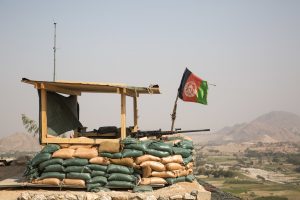By Catherine Putz

Another quarter, another quarterly report from the Special Inspector General for Afghanistan Reconstruction (SIGAR). As usual the report is big and contains myriad sections detailing the state of the oversight mission tasked to SIGAR within the context of the state of war.
As of the end of fiscal year 2020 (which ran from October 1, 2019 to September 30, 2020), appropriations for reconstruction and related activities in Afghanistan since 2002 had reached $141.24 billion. According to SIGAR, citing the U.S. Defense Department’s June 30 Cost of War Report, the Pentagon’s “cumulative obligations for Afghanistan, including U.S. warfighting and reconstruction, had reached $805.8 billion.”
One statistic highlighted in the report which is sure to get attention is this: According to U.S. Forces-Afghanistan (USFOR-A), average daily enemy-initiated attacks in the country were 50 percent higher in the July-September 2020 quarter than in the previous quarter. The military also, SIGAR notes, characterized overall enemy-initiated attacks in the most recent quarter as “above seasonal norms.”
That may be true for natural seasons, but negotiation season hardly adheres to the laws of nature.
On September 12, negotiations finally began in Doha, Qatar between the Afghan government and the Taliban. It took about a month for the two sides to settle on some (but not all) ground rules, or so Reuters reported in early October. The Afghan government called the report “incorrect.” The Taliban also denied the report. At present, the two sides remain held apart with analysts pointing to two main issues: jurisprudence and whether to build any agreement between the two sides upon the U.S.-Taliban agreement settled in February 2020.
Meanwhile, despite ongoing instability, the U.S. has moved ahead with its withdrawal plans. The U.S.-Taliban agreement envisioned a total U.S. withdrawal by May 2021. As of October 18, the Office of the Under Secretary of Defense for Policy (OUSD-P) told SIGAR that plans remained in place to draw down to between 4,000 and 5,000 U.S. troops by the end of November 2020.
In context, the doubling of violence between the second and third quarters of 2020 is aimed specifically at amping up the pressure on Kabul at a time when Washington is not only looking to the exit door, but actively moving toward it. SIGAR notes that the Defense Department certainly already believes this, saying, “The Taliban is calibrating its use of violence to harass and undermine the ANDSF and [the Afghan government], but [to] remain at a level it perceives is within the bounds of the agreement, probably to encourage a U.S. troop withdrawal and set favorable conditions for a post-withdrawal Afghanistan.” (The footnote pegs the comment to a June 2020 Defense Department report, underscoring just how not-new the trend is).
The Defense Department warned in October that the rate of violence was “unacceptably high” and that it “could undermine the agreement.” Whether Washington would actually stop its withdrawal is unclear. This is made more opaque because when SIGAR asked “whether there have been any confirmed or suspected Taliban attacks on U.S. personnel or facilities since the beginning of the Afghan peace negotiations, and whether any attacks were in violation of the U.S. – Taliban agreement” it drew a “classified response.”
Put simply: Whether the Taliban is breaking what the U.S. understands to be in the deal is not for public consumption. The Defense Department did confirm that as of October 11, no U.S. servicemembers had been killed by “hostile action” since the deal was signed.
Plenty of Afghans continue to die as the war moves forward. While civilian casualties are down in the third quarter compared to the third quarter of 2019, they are up 43 percent compared to the second quarter of 2020.
Afghan National Defense and Security Forces (ANDSF) casualties remain classified, as do various force strength numbers that would give a picture of the health and state of the Afghan security forces. The Afghan Special Security Forces (ASSF), SIGAR noted in the report, reportedly conducted more ground operations in the July-September period than it has in over a year. If enemy-initiated attacks have increased 50 percent from the second to third quarters, and ASSF operations have also increased, it isn’t a huge leap of logic to contend that casualties are up, too. We just don’t know how much.
The next quarterly report, slated for release at the end of January 2021, will give us at least something of a picture regarding how (if at all) the start of intra-Afghan negotiations in September has interacted with the ongoing violence in the country. Attacks have continued, that we know. Some have been claimed by the Taliban, others – like the horrific attack this week on Kabul University – have not been claimed by any one group.
No comments:
Post a Comment